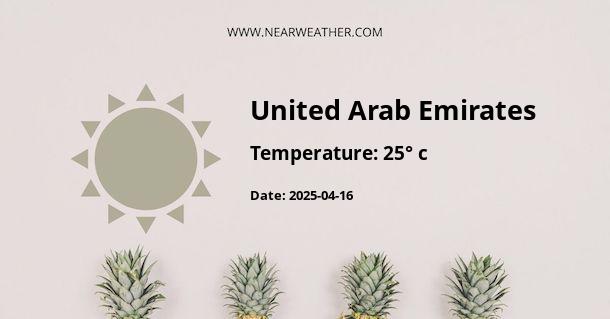Climate and Weather in the United Arab Emirates
The United Arab Emirates (UAE) is a country located in the eastern part of the Arabian Peninsula. It is known for its stunning skyscrapers, luxurious resorts, and vibrant cities. The climate and weather in the UAE are characterized by high temperatures, low rainfall, and a desert climate.
Geographical Factors
The UAE is situated in a region that is heavily influenced by the Arabian Desert and the Arabian Gulf. These geographical factors play a significant role in shaping the country's climate and weather patterns.
Temperature
The UAE experiences extremely high temperatures throughout the year, with summer being particularly hot. In the summer months, temperatures often exceed 40 degrees Celsius (104 degrees Fahrenheit) in many parts of the country, especially in the interior regions. The coastal areas, including cities like Dubai and Abu Dhabi, tend to be slightly cooler due to the moderating effect of the Arabian Gulf.
During the winter months, temperatures in the UAE are more moderate, ranging from 15 to 30 degrees Celsius (59 to 86 degrees Fahrenheit). However, it is important to note that temperatures can still drop quite significantly during the night, especially in the desert areas.
Rainfall
The UAE is known for its low annual rainfall. The country receives an average of only 100 millimeters (4 inches) of rainfall per year. The majority of the rainfall occurs during the winter months, between November and March.
Most of the rain in the UAE is in the form of short, intense showers or thunderstorms. These showers often bring relief from the heat and help to cool down the temperature temporarily. However, the rainfall is not enough to support extensive vegetation growth, and the country remains predominantly arid and desert-like.
Humidity
The UAE experiences high levels of humidity, particularly during the summer months when hot air from the desert mixes with the moisture from the Arabian Gulf. This combination can lead to a high heat index, making the temperature feel even hotter than it actually is.
Sandstorms
Another characteristic of the UAE's climate is the occurrence of sandstorms. These sandstorms, also known as haboobs, are caused by strong winds that pick up sand particles from the desert and carry them across the country. Sandstorms can reduce visibility significantly and may impact daily activities.
Climate Zones
The UAE can be divided into three distinct climate zones based on temperature and humidity:
- Coastal Zone: The coastal areas of the UAE, including Dubai and Abu Dhabi, have a relatively milder climate compared to the interior regions. The proximity to the Arabian Gulf helps to moderate the temperatures, and the sea breeze provides some relief from the heat.
- Interior Zone: The interior regions, such as Al Ain and Liwa Oasis, experience higher temperatures compared to the coastal areas. These regions are characterized by hot and arid conditions, with little to no relief from the heat.
- Mountain Zone: The mountainous regions, like Jebel Jais and Hatta, have cooler temperatures compared to the rest of the country. The altitude allows for lower temperatures and even occasional snowfall during the winter months.
Best Time to Visit
The best time to visit the UAE is during the winter months, from November to March, when temperatures are more moderate and rainfall is slightly higher. This period offers more comfortable weather for outdoor activities and sightseeing. However, it is important to note that this is also the peak tourist season, and popular attractions may be crowded.
For those who can tolerate the heat, visiting during the shoulder seasons of spring (April and May) and autumn (September and October) can be an option. During these times, the weather is warm to hot, but the tourist crowds are thinner, and hotel rates may be more affordable.
Conclusion
The United Arab Emirates experiences a desert climate with high temperatures, low rainfall, and high levels of humidity. The country's geographical location and proximity to the Arabian Desert and Arabian Gulf greatly influence its climate and weather patterns. Visitors to the UAE should be prepared for extreme heat during the summer months and consider visiting during the winter season for more comfortable weather conditions.
A - United Arab Emirates's Latitude is 24.000000 & Longitude is 54.000000.
A - Weather in United Arab Emirates is 25° today.
A - Climate Conditions in United Arab Emirates shows clear sky today.
A - Humidity in United Arab Emirates is 63% today.
A - Wind speed in United Arab Emirates is 27.18 km/h, flowing at 328° wind direction. today.
